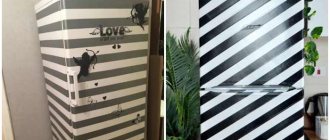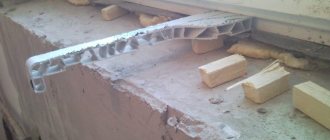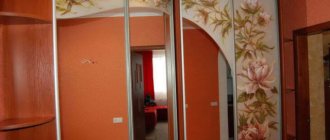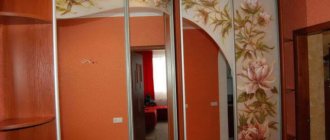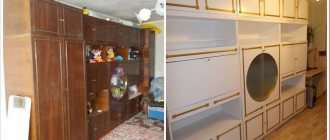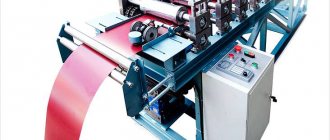Instructions on how to choose an electric fireplace include, first of all, an assessment of its power. Then they decide on the complete set: only a fireplace for a ready-made niche or a fireplace set with a portal. You should consider the quality of materials, the type of heater (heating elements, spirals, etc.), adjustment options, and flame simulation. Select standard sizes: floor-mounted, wall-mounted, corner, built-in, ovens, baskets, mobile, mini. You can build an electric fireplace yourself - it is based on the same heating elements and filaments as in conventional electric heaters.
Electric fireplaces: description, characteristics, device
Basically, the operating principle of electric fireplaces is similar to that of air heaters, fan heaters, and convection-type devices. Often products have the same heating elements. The difference is that in this case the decorative role for the design of the room and options for user comfort are not secondary. A real hearth is imitated: a portal, fire, logs, smoldering coals. Moisturizing, aromatization, and audio accompaniment may be provided.
It is necessary to distinguish between an electric fireplace with and without a heating function, only for decoration; strictly speaking, it is more appropriate to apply the term “false fireplaces” to such models.
Reputable brands in the electric fireplace segment: Dimplex, Twin-Star Inter, Electrolux, Royal Flame, Danville, Zanussi, Alex Bauman, domestic Glenrich.
Electric fireplace design
Elements and composition of the electric fireplace design:
- hearth with firebox - a “heart” with a heating element producing and transmitting heat in the form of a heating element (incandescent filament in a protective tube) or a ceramic-based coil. The firebox has a decorative and protective design: casing, grates, tempered glass. There are also reflectors, reflectors - radiating surfaces for the accumulation and distribution of heat flows. As a rule, they are supplemented with a fan that provides convection;
- portal - a niche for a fireplace. In compact mobile devices, its role is played by the casing, frame, and housing. Externally, the portal can imitate stone, brickwork, have forged metal gratings, and quartz glass screens. Dimensional designs can completely replicate the appearance of conventional fireplaces, have an imitation of a chimney, countertops;
- control system: thermostat, remote control, flame brightness adjustment and similar settings;
- system for simulating fire: LCD monitors, fabric with a fan or a steam generator with lighting, decorative logs, coals, stones.
Required materials and tools
There are many options for building an electric fireplace. However, in most cases they differ in the shape of the portal and external decoration. In any case, before making it, you need to stock up on materials and tools.
Materials:
- metal profile for the frame;
- drywall;
- asbestos;
- liquid putty;
- primer;
- mesh for seams;
- insulation;
- self-tapping screws;
- metal corners;
- ceramic tile;
- chipboard;
- glue.
Be sure to have a set of the following tools with you:
- spatula, it is better to take a small one;
- screwdriver;
- stationery knife;
- fine sandpaper;
- metal scissors.
You may also need a hammer and a building level.
Choosing electric fireplaces: what to look for, power, design types
What you need to consider when choosing an electric fireplace:
- decide what you need: heating or more of a decorative function;
- power;
- type of control;
- type of heating elements, heating;
- a complete set with a portal or only a part (with a heater) for installation in an existing niche;
- installation type, shape, size;
- decorative design, imitation quality;
- additional options (humidification, sound, aromatization).
The decorative design option is not secondary, but sometimes plays a decisive role. Fireplaces are traditionally one of the central elements of the home, setting the overall tone and creating the atmosphere. The sight of flaming logs, soft light from the fire, various design solutions for the portal and effects are important.
For one heating function, one could limit ourselves to a heater or convector. But an electric fireplace is not just a box with hot coils or a radiator with a heating element. The device is intended to decorate a home, so its decorative qualities are also taken into account. Based on functionality parameters, energy consumption, power, quality of materials and elements, and management are assessed.
Power
Typically, the minimum power is 500 W, the average and most common is 2–3.5 kW, high levels are from 4–6 kW.
It should be taken into account that there are electric fireplaces that do not heat at all (without a heating function), but only serve as decoration, imitate a flame on the screen, or in other ways.
If the slope is greater for the design, then you can select the minimum consumption with a standby mode (temperature maintenance) of about 100–200 W. If the electric fireplace is like full-fledged heating, then the choice begins with models from 2 kW with a heating function.
Most models perform two functions - interior decoration and full heating - simultaneously. The only question is the price: the higher the power and the better the design, the more options, the more expensive the product.
You can select a device with a “reserve”, since there is a thermostat as standard. Energy will be spent only in the required amount, according to the values set by the user.
Minimum or average power is suitable for the autumn and spring periods for an apartment. When the central heating has been switched off but there may be a short period of low temperatures.
The best choice: an electric fireplace with both the function of heating and decorating a room. We select power at the rate of 2 kW per 20–25 m².
Dimensions, shape, equipment
You can buy a complete fireplace set with a decorative small portal or a prefabricated structure to create it. If a niche in the room is already ready or they plan to create it from scrap materials, then they buy a fireplace, that is, only a housing with heating systems, fire simulation, and control.
The device must be commensurate with the room; according to traditional rules, the fireplace is the central element.
Recommendation: the width of the device or portal is no more than 1/3 of the same parameter of the longitudinal wall, but this rule does not apply to installation near corner walls. If there is a shortage of space, you should not choose products that are too protruding - there are flat models on sale. Comfortable width to the wall is about 70 cm.
Types of electric fireplaces
There are electric fireplaces on sale for any room parameters:
- floor The most popular, classic, often complete with a portal. Some models are equipped with a cast-iron grate and forged firewood;
- wall-mounted, hanging fireplace screens. Compact, fastened with special brackets, and lightweight. The shape is flat, narrow, in the shape of squares and rectangles. With tempered glass protection, which makes them look like screens. Strict, stylish and minimalist design;
- floor-mounted for installation in corners. The advantage is that you can perfectly decorate a room and at the same time save space;
- built-in For equipped niches. Can be hung or supported on the floor and walls. There are models with transparent edges for installation on the side of the walls, their disadvantage is that they are difficult to install;
- ovens. Reminds me of a potbelly stove. Made of durable metal, compact, mobile. They look beautiful even without a portal. A good option for small rooms;
- baskets. The most compact models are an imitation of a box with smoldering coals or burning logs.
Models that require the least installation effort are more popular, but this is not the main selection criterion. Guided by personal preferences and room parameters.
Heating element options
The electric heating unit consists of a heating element or coil, a thermostat, a reflector, and a fan for better heat distribution.
Types of heating elements:
- closed: heating elements, standard with ribs;
- tape;
- monolithic (flat solid metal cases);
- filaments in metal or glass quartz tubes (transparent, frosted). Often this design uses infrared heating. IR elements are the best choice because they do not dry out the air;
- spiral between ceramic rods, on a ceramic base. Minus: it dries out the air, the filament burns out more often, but replacing it, the fireplace itself and heating are cheaper. Feature - heats up extremely quickly, but also cools down;
Advanced models of electric fireplaces have heaters made by spraying a special material onto a circuit board.
The best choice: an infrared heater of a tubular design or in a monolithic body, and ideally a combined type, with the ability to switch to IR and conventional heating. It should be noted that high-quality devices are equipped with conventional heating elements, since IR cannot always ensure the effective distribution of heat flows.
Control
Old models were equipped with a switch in one range - to select simultaneously working spirals. Constant adjustment of the most comfortable climate was required, and its range was extremely limited.
Modern products have control with a heating regulator (thermostat with rheostat), types:
- mechanical - a small selector, a knob with positional or smooth adjustment of the thermostat, you can save money by reducing power;
- electronic. Allows you to make settings using a remote control panel or touch panel, buttons on the control unit with indication.
Advanced electric fireplaces are equipped with automatic controls with the ability to set an operating algorithm, for example, when a sensor detects a certain temperature in the room, the fireplace autonomously reduces the heating intensity. You can also program the operating duration.
Material
High-quality products have portals made of natural materials, metal, stone, plaster. You can choose polyurethane (polymer): it looks good, it is a high-quality material that does not emit harmful substances. It is recommended to exclude plastic parts - they can produce toxins and an unpleasant odor.
Flame simulation options
An electric fireplace is positioned not only as an efficient heating device, but also as a room decoration. Often the main determining factor in the choice is the need for an interior element for decoration. The more complex the visualization and flame simulation system, the higher the price.
Mask rotation
In the firebox, a mask with holes is attached to a rotating structure, and there is a backlight at the base. When turned on, the mask rotates, the light is refracted, a play of shadows appears, similar to the pulsation of flames. The most ancient and primitive method, the credibility is low, but it’s better than nothing.
Fabric tapes
The fluttering strips of fabric are also a primitive and implausible imitation. At the bottom of the firebox there is a backlight and a fan, which simultaneously provides convection. The unnaturalness of the “flame” is noticeable, so it is recommended to contemplate the effect from afar.
Video
A flat screen with different versions of videos showing real flames simulates it extremely realistically. Realism can be complemented by audio accompaniment (crackling, hissing). It is advisable to select a device with a monitor with a 3D effect. The downside is that the video is repetitive.
Cold steam generator and lighting
Imitating flames with steam and lighting is the most realistic and expensive. It is also called LED technology, as it uses special lighting for a 3D effect. Operating algorithm: an ultrasonic generator evaporates water, steam enters the combustion chamber. The illumination rays are refracted, creating an extremely reliable imitation of fire. All you need to do is periodically add water, preferably distilled.
More precisely, it creates not hot, but cold steam - fog, haze. This technology has different modifications (Real Fire, Opti-Virtual) using mirrors (the so-called “Pepper’s ghost” technique), special light to connect the “fire” with a dummy log
An additional and extremely important advantage of electric fireplaces with steam generators is air humidification.
It should be especially noted that three-dimensionality appears, something like a hologram; such a “flame” looks extremely reliable from any distance, from different sides, and there is often an option to change the color of the fire and brightness.
When purchasing, it is important to look at how long one filling of the steam generator with water is enough for its continuous operation (can range from 2-3 hours to a day).
The steam visualization system in electric fireplaces is called the “living flame effect”. These are the most expensive and sought after models. When choosing and purchasing, you need to clarify this parameter, since sometimes this phrase is added to other options for simulating fire.
Additional options
Advanced options make the electric fireplace more expensive, but in this case the product is designed to create comfort, so this aspect is important, and sometimes has a significant amount of practicality.
Additional features are standard:
- remote control with remote control;
- adjusting the brightness and color of the flame;
- overheat protection;
- modes, smooth adjustment of power, heating intensity;
- audio accompaniment;
- aromatization. There is also a practical aspect - the option can be used instead of conventional air fresheners;
- humidifier. In new models, the heating elements are closed, so they dry the air less. Still, humidification is always considered useful and provides climate control. As a rule, this option is present by default in models with steam generators;
- heating mode with infrared radiation, which is better than convection - the heat does not heat the air itself, drying it, but is immediately transferred to surfaces and is perceived by the body as sun rays;
- timer;
- climate control.
The inner part of the frame
When making the inside of the frame, keep in mind that the dimensions will increase due to the hearth itself and the lining. Even if it is a fairly thin heat-resistant tile, you will need to “fit” into the dimensions. When making a chimney, a profile for partitions is used. The frame for beauty is made up to the ceiling (you can do without a fireplace chimney). Then you solve the issue with the electrical wiring (if you haven’t already solved it before). It is better to run the wire inside a homemade portal in a metal hose.
For cladding we use prepared plasterboard sheets. To cut them, you can take a stationery knife with a retractable blade. But you should sew up electric fireplaces using a screwdriver (use metal screws for fastening). After that, all the joints between the pieces of drywall are puttied. In this case, you should strengthen all corners of your fireplace structure without exception with perforated corners.
An example of the best electric fireplace
Parameters of a high-quality electric fireplace for heating an apartment or house:
- heating and decorating function at the same time;
- several heating and fan modes;
- timer and programmability;
- climate control or at least humidification;
- operating modes, heating adjustment is smooth or with many steps;
- remote control;
- combined type of heater: convection and IR. However, you can only get by with the first option, since most heating elements are closed and weakly dry the air, and especially if there is humidification;
- imitation of flame using a steam generator.
Advantages
Among the positive characteristics of such heating devices, the following features can be noted:
- Fast, almost instantaneous heating of the room.
- Environmentally friendly use, since no carbon monoxide or other harmful substances are generated during operation.
- Ease of operation, which is ensured by convenient adjustment of functions, absence of ash and other fuel waste.
- You can set the modes to choose from: either only flame (if there is no need to heat the room), or heat without fire.
- Installing an electric fireplace does not require the construction of a chimney to remove combustion products. In this case, it can only be used as a decorative element.
- Light weight (within 50 kg) and compact dimensions.
- The modern design of the unit fits almost any interior style.
- To heat an apartment with such a device, permits from the relevant services are not required.
- The presence of a thermostat that will not only monitor the desired heating temperature of the room, but also the economical consumption of electricity. In addition, the room will heat up faster due to the existing fan.
- Relatively low cost, affordable for all categories of consumers.
- It is convenient to install the device in different places in the room where there are sockets nearby.
- High level of fire safety due to the fact that the body of the electric fireplace remains cool at any heating temperature.
DIY electric fireplace
The easiest way to make an electric fireplace with your own hands is to buy a ready-made fireplace and create a portal with your own hands. You can also purchase only the heating unit and install it in a homemade firebox.
The first step is always planning with at least a rough drawing. It is important to indicate the exact dimensions in order to avoid distortions in the structure.
You can create a portal without some elements, but let's look at the full view, starting from the bottom:
- a podium with a floor frame around the perimeter, that is, a lower tabletop on which the frame is placed;
- the portal itself;
- upper tabletop (top of the portal);
- fake chimney. You can do without it.
Assembly is carried out in the above sequence. To create an electric fireplace for an apartment with your own hands, step-by-step instructions include the following steps:
- Plan, drawing.
- Selection of materials for the frame: profiles, wooden planks, for cladding - gypsum plasterboard, plywood. Self-tapping screws, bolts, screws, nails and even glue are suitable for fastening.
- Creating a frame, covering it and decorating it.
- Arrangement of firebox, fireplace hearth.
Frame
The frame can be assembled from metal strips fastened with self-tapping screws, rivets, bolts and nuts. You can use profiles from prefabricated shelving. For example, the outer edges should be made with rack profiles (60×27 mm), and the lintels with guides (27×28 mm).
There should be at least 18–20 cm from the firebox to the walls of the internal niche. The frame is heavy, so it must be secured to the wall with self-tapping screws and dowels.
The lower tabletop is fixed with corners, the portal frame is mounted on it, so the base is strengthened - more profiles are used, with smaller gaps. Usually the portal is 2 times wider. The firebox space is separated by horizontal slats, strengthening the structure. The portal is crowned by another tabletop.
The sheathing is made of plasterboard - it can be easily cut with a hacksaw. For fastening, the same self-tapping screws, bolts are used, even construction glue will do. Instead of gypsum board, you can use any suitable materials - plywood, tin.
The final stage is painting, or you can use wallpaper and similar materials. There are also thick polymer flexible sheets with imitation stone on sale.
Using the above principle, a chimney is created (you can do without it). Usually it has a width equal to the portal, but protrudes less. If it is used to hang a TV, then the fixation point is additionally reinforced with jumpers made from profiles.
Heating element from other devices, reflectors, fans
To make an electric fireplace “from scratch” with your own hands, we first select a heating element. Any incandescent coil from other devices will do, but if you take it, for example, from an iron, you will need several pieces for a power of 1–2 kW. For this reason, it makes sense to use larger heating elements, for example from air heaters, convectors. You can take such working devices and decorate them like a fireplace, without even disassembling them.
The factory-made electric hearth and firebox can be placed on any surface - since there is no fire or sparks, and the casing of the structure is sufficient to prevent heating from causing a fire. It is important to place the heating element, purchased or removed from other devices, on a thick, completely non-combustible base - a layer of crushed stone, bricks, metal sheets, a structure with legs. This will also raise the device, allowing heat to spread more efficiently.
It is important to frame it with reflectors (reflectors) - any metal sheets, tin. By placing mirror surfaces (you can attach foil to the metal) behind and on top of the firebox, you will get a three-dimensional visual effect of the flame.
Fans will improve the distribution of heat; in their role, you can use impellers from household appliances (from hoods, etc.), and computer coolers.
Decoration, imitation flame
The imagination for decoration materials is limitless:
- any textured real stones, coals, logs;
- imitations made of cardboard, plastic, papier-mâché;
- lighting is done with ordinary light bulbs;
- To simulate fire, you can take a small computer cooler and thin fabric.
Simulated flame
Modern electric fireplaces use tricks of a completely different kind to simulate combustion. In them, realistic fire is born using an ultrasonic steam generator on a quartz plate! Jets of steam from it, rising upward, fall into the rays of the backlight bulbs and become visible to the eye. Moreover, the effect is so realistic that it is scary to touch the “tongues” of this flame with your hand. Although this is just steam formed at room temperature by vibrations of a quartz plate under the influence of an electric current.
It is quite possible to make a similar steam generator at home with your own resources and resources, as the following video proves.
Doing something like this is very difficult and will require some knowledge or qualified help from an electrician.
To make your own version of a realistic electric fireplace, we will need:
- Fan (cooler from a computer).
- Ultrasonic steam generators.
- DMX converter.
- LED lights.
- Waterproof box.
- Distilled water.
We attach ultrasonic steam generators (preferably several) to the bottom of the waterproof box. They will promote the evaporation of water, and a fan located on the side will drive the vapors upward, preventing them from cooling prematurely, swirling and falling.
Lamps are needed to illuminate the rising steam, which in their rays will create the effect of “burning” of decorative firewood, with which this entire cunning structure must be reliably covered.
How to install an electric fireplace
Installing a factory electric fireplace is extremely simple - you just need to connect it to the network. But there are recommendations for placement and safety:
- It is advisable that the outlet be hidden - this way it will not spoil the interior. It can be located below and hidden behind furniture elements or behind the firebox on the wall to which the portal is attached;
- wall-mounted fireplaces are heavy, so it is desirable that the supporting surface be solid (brick, concrete); if it is made of thin wood, chipboard, plasterboard, then it must be attached directly to the frame (to the slats) of such a partition or with special dowels (“molly”, butterflies) ;
- grounding, automatic protective shutdown (RCD or automatic circuit breaker) are required. Individual line recommended. We need to calculate the wiring. In modern houses, it is standard copper with conductors with a cross section of 2.5 mm², and can withstand up to 5.9–6.6 kW;
- The electrical hearth should be easily retractable for maintenance.
Placement nuances:
- bright places with rays of sun will spoil the special effects, so the fireplace is installed in shaded locations, at least not close to the windows;
- if there is a TV above the fireplace, then there should be at least 50 cm to its lower edge;
- wall-mounted models can heat up excessively when installed close to the floor, the minimum gap should be about 10 cm;
- the device burns oxygen, so the room must have at least minimal ventilation (a gap at the bottom of the door will be sufficient).
Preparatory stage
Before you start making a false fireplace, you need to think about its installation location and power supply.
Selecting a location
Work on creating a homemade electric fireplace should begin with choosing a place for it, since the shape of the portal will depend on this. The following options should be considered:
- Wall-mounted location: this is the most preferable option - it is the wall-mounted electric fireplace that is most similar to the real one. But such an installation is possible only under one condition: the room must be quite spacious. In the wall-mounted version, the electric fireplace is made rectangular.
- Corner: this method is used if the room is of modest size. The corner is usually the least used area, so installing a false fireplace here has almost no effect on the amount of free space. The corner portal will no longer have a rectangular, but a triangular base.
A corner electric fireplace will not take away useful space from the room
- Wall-mounted option: as you know, a floor-mounted fireplace is considered classic. But the mounted option will look good, provided that the space in front of it, at least a few steps away, is not cluttered with anything.
- Built-in fireplace. This option will significantly save space.
An electric fireplace built into the wall is ideal for small rooms.
If the problem of lack of space is so critical that none of the above options are suitable, an electric fireplace can be built into a partition or furniture. Especially for such tasks, “ultra-thin” fireplaces with a depth of only 7 cm are produced. By the way, it’s worth considering that perhaps such an almost flat fireplace could be made wall-mounted.
When choosing a place for a fireplace, take into account the position of the window: it is advisable that daylight does not overshadow the backlight.
Some users are faced with a problem: no matter where they place the fireplace, it always ends up close to one or another piece of furniture - a table, sofa, pouf, etc. The way out of this situation is to create a wall-mounted fireplace located at a certain height. In this form it will not lose its decorative qualities. At the same time, at any distance from the wall and even under the fireplace itself, it will be possible to place a low piece of furniture.
Hanging electric fireplace significantly saves space
Electricity supply
An important point: at the preparation stage, you should think about the power supply to the fireplace. To prevent the impression of the decoration from being spoiled by an extension cord stretched across the entire room, you need to attach an electrical outlet to the wall near the installation site of the portal. In this case, it is useful to listen to these recommendations:
- You should not install the socket so that it is inside the portal, although this option seems to be the most successful from an aesthetic point of view. A false fireplace, like any other electrical device, is potentially dangerous, and the user should be able to quickly unplug the power cord if something happens.
- It is better to install an outlet with a switch. After installing the fireplace in the portal, the standard power button will most likely be difficult to access, and it will be inconvenient to constantly pull out and insert the plug into the socket to turn the device off and on.
Christmas garlands
Preparing branches All people love the New Year. Therefore, every person has more than one Christmas tree garland in their home. But few people know that with its help you can easily and quickly make an artificial fire in a decorative fireplace with your own hands. Therefore, this method is considered one of the simplest and most effective. Moreover, anyone can handle it, and the cost is very low. To make the flame look like a real one, you will need the following materials:
- tree branches of various sizes;
- aluminium foil;
- lace. It can be easily cut from an old dress;
- stones (several pieces);
- glue;
- Christmas tree garland with a background color of red, orange or yellow. The best solution would be to use a flickering garland.
The simulation structure is assembled as follows:
- wrap the branches with foil without gaps;
- coat the lace with glue and attach it to the branches. Next, wait until they are completely dry;
- Next, you should carefully cut the lace case and remove the blanks from them;
- after that, in the hearth of stones, we lay out the stones in a circle;
- We place a garland in the middle of the resulting circle, and bring the cord and plug out;
- We place the resulting “lace” firewood in the manner of a fire.
Stages of forming a fire: Plug in the garland and enjoy the imitation of fire! As you can see, this method is very easy to implement and will cost you much less than all other methods.
Portal Design Guide
When choosing materials for decorating a fireplace portal, be guided by your preferences, available budget and the design features of the room.
As a rule, fireplaces installed in combination with portals practically do not heat up during operation and weigh a maximum of several kilograms, so there are no special requirements regarding the heat resistance of materials and their strength.
Plasterboard fireplace
To decorate the portal, you can use decorative brick, stone, glass, metal, wood boards, plasterboard, plastic panels, etc. Experts only recommend avoiding the use of plywood and solid wood, because... Such materials dry out very quickly and become deformed under the influence of hot air.
Polyurethane and gypsum are also widely used for finishing fireplace portals.
For the rest, follow your preferences. The following will provide guidelines for arranging portals using the most popular and easy-to-install materials.
Preparing for independent construction
How to make such a device with your own hands? Let's take it step by step.
Before you begin, you must do the following:
- understand what interior style the future device should suit;
- determine the dimensions, comparing them with the parameters of the room where it is planned to be installed;
- highlight the location of the device;
- select the tools required for the job: hammer, screwdriver, building level, screwdriver, scissors for cutting metal.
Using plaster
Finishing a fireplace with your own hands is possible by applying plaster. This method is very simple and does not require large financial investments. Cladding does not require strengthening the foundation of the fireplace, and after some time the surface can be easily updated or another decorative solution can be chosen.
You need to choose heat-resistant mixtures that include fixing components, for example, clay, lime, asbestos additives, hemp and straw. If the plaster contains fibers, then its reinforcing properties increase by several orders of magnitude.
And for decorative purposes, the surface must subsequently be painted with heat-resistant paint materials.
The plaster is applied using the following technology:
- removing old coating and cleaning from dirt;
- moisturizing the walls of the structure;
- jointing masonry joints up to 10 mm deep for better adhesion;
- heating the base;
- fastening reinforcing mesh with nails or screws;
- diluting the mixture and applying it to the surface;
- drying the plaster for 2-3 days with periodic heating of the fireplace;
- applying decorative paint or putty to the surface.
Firebox selection
The frame, of course, plays a significant role in the construction of the fireplace, but the choice of firebox is much more important. To make the right decision, you need to know the device's design. The hearth consists of mechanisms responsible for producing heat and simulating a flame. Fire is depicted using pieces of foil or red silk. They oscillate in the air flow thanks to a special fan. There is also a mirror system and lighting. All together gives a realistic imitation of a real flame.
Electric fireplace insert - drawing
Heat is produced by heating elements. They come in two types: spiral and tubular. The latter are also called tens. Heat is distributed using a fan. The maximum possible energy consumption for a fireplace is about 2 kW.
What does a steam fireplace consist of?
The principle of the design and operation of a steam fireplace is quite simple. The fireplace consists of a steam generator, halogen lamps and logs. The generated steam goes up to the logs and is illuminated from below by halogen lamps, which creates the effect of a live fire with smoke. It is the thick steam near the logs, illuminated by lamps, that looks like tongues of flame, and then it, dissipating a little, becomes “smoke.” Lamps also provide warmth, but this warmth is more of an imitation, which simply adds to the realness of the fireplace. The fireplace also contains a container for filling “fuel” - water, which is converted into steam under the influence of high temperature. The generator sprays steam into the diffuser and clouds emerge from it to the surface, creating a uniform spray.
Halogen lamps are equipped with a special light filter, thanks to which the glow of the lamps is more similar to the colors of the flame.

